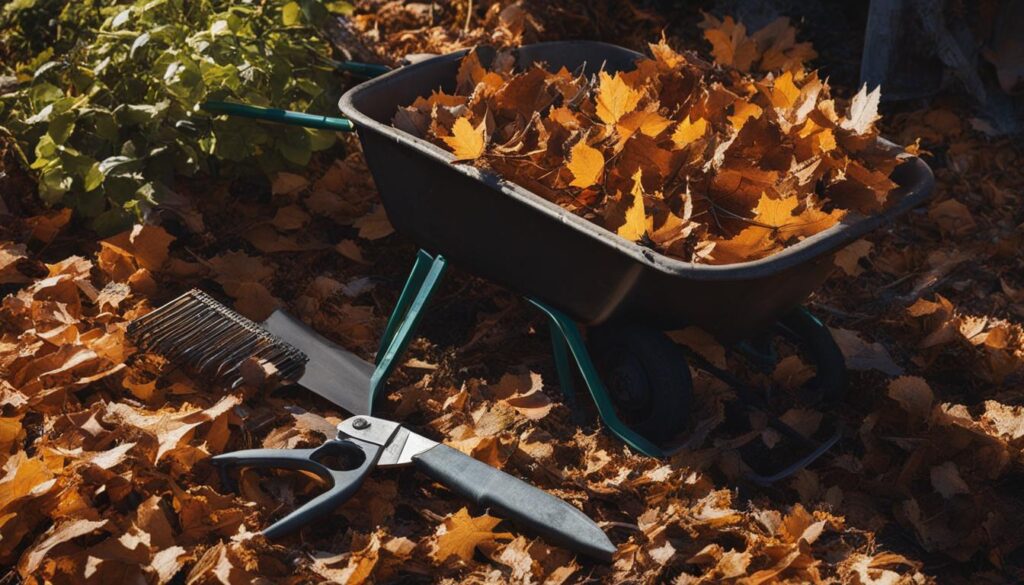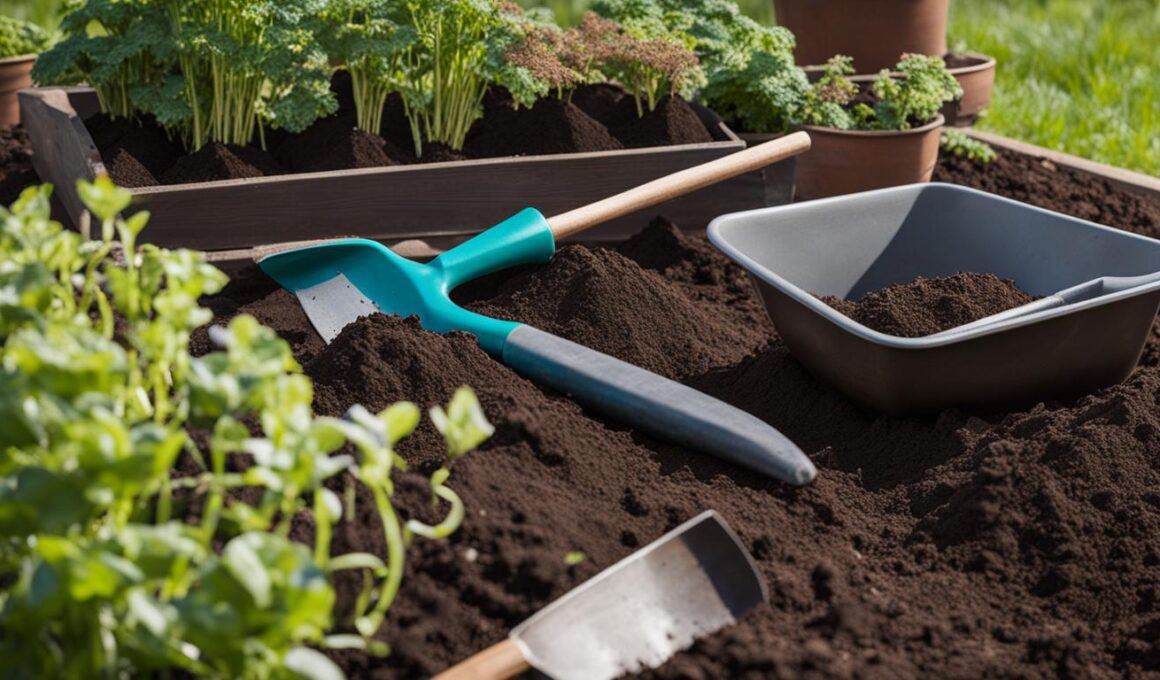As the temperatures rise and spring approaches, it’s time to prepare your backyard garden for a blooming season. By following these essential steps, you can ensure that your garden flourishes with vibrant blooms and lush greenery. From cleaning up your garden to planning your layout and starting seeds indoors, there are several key tasks to tackle for a successful spring garden. Let’s dive into the details to help you get started.
Post Summary:- Preparing your backyard garden is essential for a successful blooming season.
- Cleaning up your garden helps prevent the growth of diseases and pests.
- Pruning and trimming promote healthy growth and maintain the appearance of your garden.
- Assessing your soil and improving its texture and fertility is crucial for plant health.
- Thoughtful planning of your garden layout ensures a visually pleasing and cohesive space.
Clean Up Your Garden
Before you can start planting for the spring season, it’s important to give your garden a thorough clean-up. Removing debris, dead plants, and fallen leaves will not only make your garden look tidy but also prevent pests and diseases from taking hold. By taking the time to clean up your garden, you’re creating a fresh and healthy environment for your plants to thrive.
Start by raking up any leaves or branches that have accumulated over the winter months. These can harbor pests and diseases, so it’s best to clear them away. Trim back any dead or damaged foliage from your plants to promote new growth and improve their overall health. Don’t forget to clean and inspect your garden beds, pots, and tools, as well. Repair or replace any damaged containers or tools to ensure you’re fully prepared for the upcoming season.
Remember, a clean garden is a happy garden! Taking the time to clean up now will save you from potential headaches later in the season.
By cleaning up your garden and removing debris, you’re setting the stage for a successful and thriving blooming season. Your plants will thank you for the fresh start by producing vibrant blooms and healthy foliage.

| Benefits of Garden Clean-Up | Tips |
|---|---|
| Prevents pest infestations | – Remove any plant debris and fallen leaves that could attract pests |
| Avoids the spread of diseases | – Dispose of any diseased plants properly to prevent the spread of pathogens |
| Promotes plant health | – Prune back dead or damaged branches to encourage new growth |
| Makes weeding easier | – Clearing away debris makes it easier to spot and remove weeds |
By incorporating these garden clean-up practices into your spring routine, you’re taking proactive steps to prevent pests and diseases and setting the foundation for a successful gardening season. So grab your tools and get ready to transform your garden into a beautiful and healthy oasis!
Prune and Trim
In order to promote healthy growth and maintain the appearance of your garden, it’s essential to prune and trim your plants. Pruning involves removing any dead or damaged branches from trees, shrubs, and perennials. This not only helps to improve the overall health of your plants but also directs their energy towards producing flowers, fruits, and new growth.
Trimming overgrown foliage is equally important as it helps to maintain the shape and aesthetic appeal of your garden. By carefully removing excessive growth, you can ensure that each plant has enough space to thrive and that your garden remains visually pleasing. Regular trimming also prevents overcrowding, which can lead to disease and pest infestations.
When pruning and trimming, make sure to use sharp, clean tools to minimize damage to the plants. Cut back branches and foliage at the appropriate time, considering the specific requirements of each plant. You can consult gardening resources or seek advice from professionals to determine the best pruning techniques for different types of plants in your garden.

Benefits of Pruning and Trimming
Pruning and trimming offer numerous benefits for your garden:
- Promote healthy growth: By removing dead or damaged parts, you allow plants to focus their energy on developing new growth and producing flowers.
- Enhance aesthetics: Trimming overgrown foliage helps maintain the shape and appearance of your garden, creating a neat and well-maintained landscape.
- Prevent diseases and pests: Removing diseased or pest-infested branches and foliage prevents the spread of infections and infestations throughout your garden.
- Improve air circulation: Proper pruning and trimming enable better air movement around plants, reducing the risk of fungal diseases and promoting overall plant health.
It’s important to note that not all plants require the same level of pruning and trimming. Some plants may need minimal trimming, while others may require more extensive pruning. Always refer to specific plant care guidelines to ensure you are providing the necessary maintenance for each plant in your garden.
Assess Your Soil
In order to create the ideal conditions for a thriving garden, it’s important to assess the quality of your soil. Testing your soil can provide valuable insights into its pH level and nutrient content, allowing you to make informed decisions about how to improve it. Good soil is the foundation for healthy plant growth and abundant blooms, so taking the time to assess and enhance your soil is well worth the effort.
One key aspect to consider is the pH level of your soil. Most plants prefer a slightly acidic to neutral pH, typically between 6.0 and 7.0. You can easily test your soil’s pH using a soil testing kit, which is available at most garden centers or can be done through a professional soil testing service. If your soil’s pH is too acidic or alkaline, you can adjust it by adding amendments such as lime to raise the pH or sulfur to lower it.
In addition to pH, it’s crucial to evaluate the nutrient content of your soil. Nutrients like nitrogen, phosphorus, and potassium are essential for plant growth and development. Soil testing can reveal any deficiencies or imbalances in these nutrients, allowing you to tailor your fertilizer application accordingly. Based on the results, you can choose organic or synthetic fertilizers that provide the specific nutrients your soil needs.
Once you have assessed the pH level and nutrient content of your soil, you can take steps to improve it. Adding organic matter, such as compost, aged manure, or leaf mold, can enhance soil fertility and structure. Organic matter improves drainage, retains moisture, and provides a source of essential nutrients for plants. Incorporating these amendments into your soil will create a nutrient-rich environment that supports healthy plant growth.
Soil Testing Results
| Soil Component | Result |
|---|---|
| pH Level | 6.5 (slightly acidic) |
| Nitrogen | Low |
| Phosphorus | Adequate |
| Potassium | High |
Based on the soil testing results, it is recommended to adjust the pH level by incorporating lime. Additionally, nitrogen-rich fertilizers should be applied to address the low nitrogen levels, while reducing potassium inputs to balance the nutrient content. Regular monitoring and adjustment of the soil will help maintain optimal conditions for your plants and ensure a successful growing season.
Remember, healthy soil leads to healthy plants. By taking the time to assess your soil and make necessary improvements, you are setting the stage for a vibrant and thriving garden.
Plan Your Garden Layout
When preparing your backyard garden for a blooming season, one crucial step is to plan your garden layout thoughtfully. Consider the specific needs of your plants, such as sunlight requirements, plant size at maturity, and the color scheme you’d like to achieve. By taking these factors into account, you can create a cohesive and visually pleasing space that promotes the healthy growth of your plants.
To start, evaluate the amount of sunlight each area of your garden receives throughout the day. Certain plants thrive in full sun, while others prefer partial shade or even full shade. By understanding the sunlight requirements of your plants, you can strategically place them in areas where they will receive the optimal amount of light.
Another important consideration is the size of your plants at maturity. Some plants, such as tall flowering perennials or big shrubs, may overshadow smaller plants if placed too close together. By planning your garden layout with the size of each plant in mind, you can ensure that they have enough space to grow and flourish without competing for resources.
| Plant | Sunlight Requirements | Size at Maturity | Color |
|---|---|---|---|
| Rose | Full Sun | Tall Bush | Various Colors |
| Hosta | Partial Shade | Medium | Green and Variegated |
| Geranium | Full Sun to Partial Shade | Low Spreading | Red, Pink, or White |
Lastly, consider the color scheme you’d like to achieve in your garden. Some gardeners prefer a vibrant mix of colors, while others opt for a more monochromatic or complementary scheme. By carefully selecting plants with different flower colors and foliage, you can create a visually appealing garden that suits your personal style.
Remember, planning your garden layout is a key step in preparing your backyard garden for a blooming season. By considering sunlight requirements, plant size at maturity, and the color scheme, you can create a well-designed space that promotes the healthy growth and beauty of your plants.
What Types of Fiberglass Planters Are Best for a Blooming Garden Season?
When selecting fiberglass planters for a blooming garden season, considering the specific requirements of your plants is crucial. Opt for lightweight and durable options that offer proper drainage to prevent overwatering. Consider the size and shape that complements your garden, along with a design that adds aesthetic appeal. Research reputable brands and check customer reviews to ensure quality. Knowing how to select fiberglass planters will help you create a thriving garden space.
Conclusion
With these essential steps, you can set your backyard garden up for success this spring. By cleaning up, pruning and trimming, assessing your soil, planning your garden layout, starting seeds indoors, and preparing for pests, you create the perfect conditions for a vibrant and thriving garden.
Remember to monitor your garden’s progress, address any pests or diseases, and provide the necessary care for your plants. By following organic gardening practices, you can foster a healthy ecosystem that supports the growth of vibrant flowers and bountiful harvests.
Take pride in your efforts and enjoy the rewards of your labor. Your backyard garden will become a haven of beauty and a source of fresh, organic produce. Embrace the joy of gardening and relish in the tranquil and rejuvenating experience it provides. Happy gardening!
Should I Avoid Planting Yarrow in My Backyard Garden to Ensure a Blooming Season?
If you want to ensure a blooming season in your backyard garden, it’s best to avoid planting yarrow with other dominant plants. Yarrow can spread quickly and dominate other plants, so it’s best to carefully consider its placement in your garden to avoid overcrowding and competition.
FAQ
What is the first step in preparing my backyard garden for spring?
The first step is to clean up your garden by removing leaves, dead plants, and debris that accumulated over winter.
Why is cleaning up my garden important?
Cleaning up your garden provides a fresh start for your plants and helps prevent the growth of diseases and pests.
When should I prune my plants?
It is recommended to prune back dead or damaged branches from your trees, shrubs, and perennials in the spring.
How does pruning benefit my plants?
Pruning promotes healthy growth and allows your plants to focus their energy on producing flowers, fruits, and new growth.
How can I improve my soil for a thriving garden?
You can test your soil’s pH level and nutrient content and amend it accordingly. Adding organic matter like compost can also improve the soil’s texture and fertility.
What should I consider when planning my garden layout?
Consider factors such as sunlight exposure, plant size at maturity, and desired color scheme. Tailor the layout to meet the specific needs of your plants.
Can I start seeds indoors for my spring garden?
Yes, starting seeds indoors can give your plants a head start and ensure they are ready to thrive when it’s time to transplant them outdoors.
How can I prepare for pests in my garden?
Monitor your garden regularly, address any pest issues promptly, and provide the necessary care to keep your plants healthy and resilient.
How can I ensure the success of my backyard garden this spring?
By following the essential steps of cleaning up, pruning and trimming, assessing your soil, planning your garden layout, starting seeds indoors, and addressing pests, you can set your garden up for success.
What can I expect from my garden after following these steps?
With proper care and attention, you can enjoy a vibrant and thriving garden with beautiful flowers and delicious homegrown produce.









